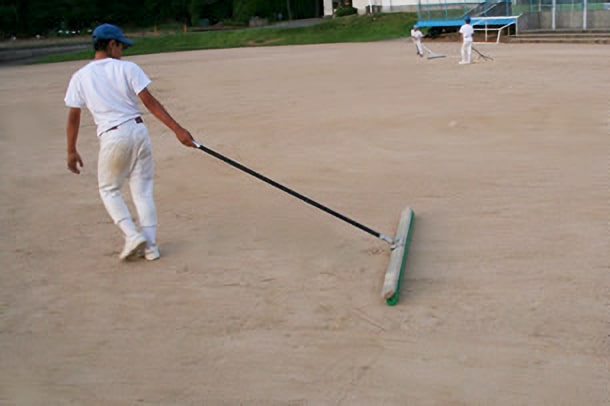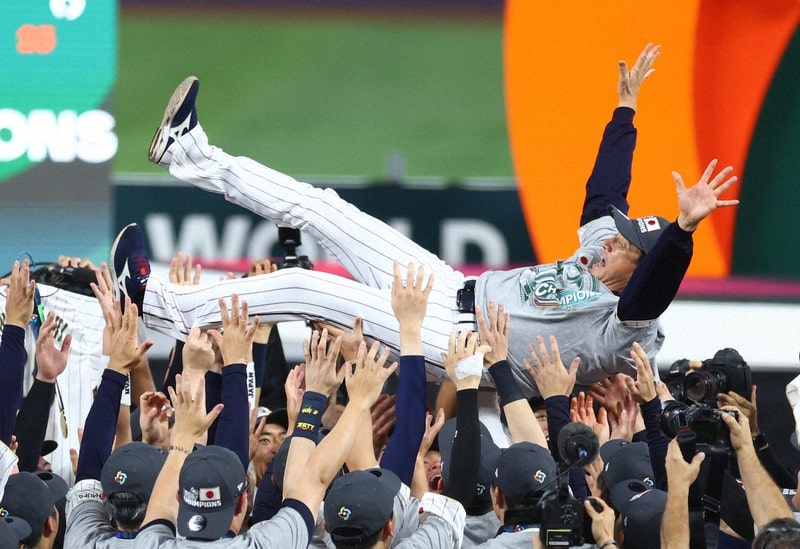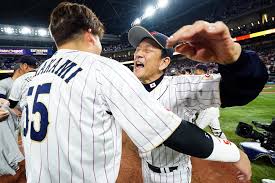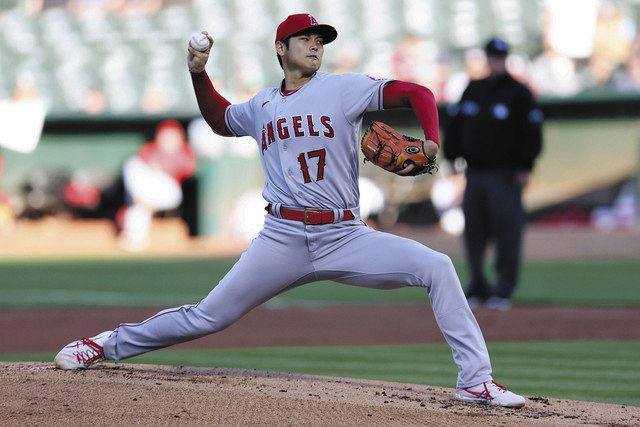
Shohei Otani is known as a one-of-a-kind two -way player who plays in the Major Leagues .
His batting form and pitching form are key factors in his outstanding performance.
In this article, we will explain Shohei Ohtani’s form in detail and explore the secret to his success.
目次
Shohei Ohtani’s batting form
Shohei Ohtani’s batting form combines both power and precision, and is highly praised by many baseball fans and experts.
Below, we will explain in detail the basic structure of his batting form, the mechanics of his swing, and the points that generate power.
Basic structure of batting form
Shohei Ohtani’s batting form has a very balanced structure.
His form has the following characteristics:
First, the stance is slightly wider than shoulder width, keeping the center of gravity low.
This increases the stability of your lower body and allows for stronger swings.
His knees are slightly bent, allowing him to easily rotate around his hips.
The width of your stance and the angle of your knees are important points for efficient power transmission during the swing.
Next is how to hold the bat. Ohtani has a firm grip on the bat, but he also holds it flexibly without using too much force.
This allows you to balance swing speed and accuracy.
The bat is held at shoulder height, and care is taken not to open it to the pitcher.
This allows the bat to hit the ball in the shortest possible distance when hitting.
swing mechanism
Shohei Ohtani’s swing consists of a series of smooth movements.
The mechanism of the swing is as follows.
As the first step, as the pitcher enters the pitching motion, Ohtani slightly raises his left foot to take timing.
This step is called “loading” and is an important step in preparation for batting.
He uses this motion to put his weight on his hind legs and conserve energy.
Then, at the moment the ball is released, shift your weight to your front foot and rotate your hips.
This transfers the power from your lower body to your upper body, allowing you to make a powerful swing.
Hip rotation is the source of energy for the swing and is one of the biggest characteristics of his swing.
The final step is to smoothly hit the ball with the bat.
Otani’s swing is extremely compact, with no wasted movement.
He swings the bat down toward the ball the shortest distance and applies maximum force at the moment of impact.
This series of movements supports his powerful blows.
Points that generate power
The source of the power in Shohei Ohtani’s batting form can be divided into several factors.
First is lower body strength. His swing starts in his lower body, using his strong leg and hip muscles to generate energy.
In particular, the shift of weight from the back foot to the front foot and the rotation of the hips are the foundation of power in his swing.
Next is the upper body movement. The movements of his shoulders and arms are linked to the movements of his lower body, allowing him to transfer energy efficiently.
The width of his shoulders and the way he swings his arms are important factors in transmitting power to the bat, and he controls these very well.
Additionally, the speed and trajectory of the bat are also important points.
Ohtani has extremely fast bat speed, which allows him to apply a lot of force to the ball.
The bat’s trajectory is an inside-out swing, allowing you to catch the ball firmly.
This maximizes flight distance and ball speed.
As you can see, Shohei Ohtani’s batting form is extremely sophisticated, from the basic structure to the swing mechanism and the points that generate power.
His form has been perfected as a result of much study and effort, and behind his outstanding performance lies careful planning and execution.

Evolution of batting form
Shohei Ohtani’s batting form has undergone major changes during his career.
His form continues to evolve from his transition from high school to the pros, his adjustment to the major leagues, and the guidance and influence of his coaches.
Below, we will explain these changes in detail.
Transition from high school to professional
Shohei Otani’s batting form has undergone a major change from his days at Hanamaki Higashi High School to after he turned professional.
During his high school days, he was known as a batter with both power and speed, but his form was still a work in progress.
At the time, there were issues with weight transfer and swing stability, and in particular, there was a need to improve the ability to respond to fastballs.
After turning professional, Otani gradually improved his batting form through training and experience with the Nippon-Ham Fighters.
In particular, through playing against professional pitchers, I was able to clearly recognize my weaknesses and hone my skills to address them.
He was able to maintain the speed and power of his swing while improving the stability and consistency of his form.
In his first year as a professional, he achieved some success with a batting average of .238 and three home runs, but there was still room for improvement.
His batting form laid the foundation during this period and became the foundation for his subsequent development.
Adaptation in Major League Baseball
When Shohei Ohtani challenged the Major League, his batting form evolved again.
Major League pitchers have high quality fastballs and breaking balls, and Ohtani was forced to make adjustments to accommodate this.
In particular, it was required to shorten reaction time to changes in ball speed and swing at the right time.
Ohtani’s swing in the major leagues has become more compact and efficient.
He made adjustments to optimize the bat’s trajectory and maximize power transfer at impact.
In particular, the accuracy at the moment of catching the ball has improved, making it possible to mass-produce home runs and long hits.
Additionally, data analysis of pitchers is progressing in the Major Leagues, and Ohtani has analyzed his own batting form based on the data and made necessary improvements.
As a result, he continues to demonstrate high batting average and power against high-level major league pitchers.
Coaching and its influence
The evolution of Shohei Ohtani’s batting form has been greatly influenced by the guidance of many coaches.
He has been blessed with many excellent coaches since his days with the Nippon-Ham Fighters, and has grown under their guidance.
In particular, his guidance on how to balance stability and power in his swing had a major impact on his batting form.
During his time at Nippon Ham, he corrected problems in his swing while receiving guidance from a batting coach.
His coach taught him techniques to increase the efficiency of his swing while maintaining its power.
This allowed Otani to achieve much in Japanese professional baseball.
Even after transferring to the major leagues, Ohtani received a lot of guidance from the Angels’ coaching staff.
In particular, I learned techniques and tactics for dealing with major league fastballs and breaking balls.
The Angels’ coaching staff carefully analyzed Ohtani’s batting form and provided improvements suited to his swing.
As a result, Ohtani’s batting form was further refined and he was able to maintain his high performance in the major leagues.
As such, the evolution of Shohei Ohtani’s batting form is the result of continuous improvement and adaptation throughout his career.
His batting form continues to evolve as he transitions from high school to the pros, adapts to the major leagues, and receives guidance from and influences from coaches.
This effort and growth are the key factors behind his success.

Shohei Ohtani’s pitching form
Shohei Ohtani’s pitching form is an important element that supports his overwhelming performance.
His form is designed to support basic structure, release point and ball sharpness, and stamina.
These elements are explained in detail below.
Basic structure of pitching form
Shohei Ohtani’s pitching form is extremely balanced.
His form has the following characteristics:
First, at the beginning of the pitching motion, he starts in a relaxed position.
His feet are shoulder-width apart and his knees are slightly bent.
This relaxed stance allows him to initiate movements smoothly.
He then steps back and puts his weight on his back leg.
This action is an important step in conserving energy.
As his weight shifts to his back leg, he simultaneously pulls his knees up and stabilizes his entire body.
At this time, the hips also begin to rotate, using the twisting of the body to accumulate energy.
During the release phase of pitching, plant your front foot firmly and shift your weight forward.
This weight shift creates maximum force on the ball.
As his hips and shoulders rotate and his arms swing down, he transfers the stored energy into the ball.
His arm movements are very smooth and occur in a continuous sequence.
Release point and ball sharpness
Another important element of Shohei Ohtani’s pitching is his release point and sharpness of the ball.
His release point is very consistent, allowing him to release the ball from the same position every time.
This makes his pitching highly consistent and extremely difficult for hitters.
His release point is set in a position that takes full advantage of his arm length and body structure.
This is important to maximize ball speed and rotation. His arm movements are very smooth and there are no wasted movements on the way to the release point.
This allows for efficient transmission of force to the ball, increasing the sharpness of fastballs and breaking balls.
Sharpness with the ball is another powerful weapon in his pitching.
His fastball has a speed of over 160 km/h and has extremely sharp rotation.
This causes the ball to change rapidly in the batter’s hands, making it difficult for the batter to react.
His breaking ball also shows sharp changes due to his control of release point and rotation rate.
In particular, sliders and curveballs are effective weapons that allow batters to send their bats through the air.
Form that supports stamina
Shohei Ohtani’s pitching form is designed to support his stamina.
His form allows for efficient force transfer and minimizes fatigue.
First, his form is very economical. There is no wastage in his movements, and he uses his entire body to exert power.
In particular, hip rotation and weight transfer are performed efficiently, so there is no undue strain on the shoulders or elbows.
This allows you to maintain stamina even when pitching for long periods of time.
Second, he has a strong core and uses it to maintain his balance.
Core strength helps increase stability and reduce fatigue throughout the pitching motion.
His core training is extremely important in maintaining his pitching form and ensuring his stamina.
Furthermore, his recovery form is also one of the factors that supports his stamina.
His post-release motion is smooth, minimizing impact to the body.
This reduces the strain on your muscles and joints, allowing you to maintain long-term stamina.
In this way, Shohei Ohtani’s pitching form is designed to support the basic structure, release point, sharpness of the ball, and stamina.
His form combines technical refinement with physical strength and is key to his dominant performances.

Evolution of pitching form
Shohei Ohtani’s pitching form has undergone significant changes and evolution throughout his career.
From high school to Nippon-Ham to the Major Leagues, his form has been constantly improved and refined.
Below, we will explain in detail the changes in form during each period.
Changes from high school form
Shohei Otani’s pitching form has changed significantly since his days at Hanamaki Higashi High School.
In high school, he had an overwhelming style with fastball speed and power, but his form was still rough and there were issues with stability and durability.
His form was often heavy-handed, putting strain on his shoulders and elbows in particular.
With my high school form, my release point was inconsistent and my control was uneven.
This caused his pitching to be inconsistent at times.
He also had a strong tendency to rely on fastballs, and his breaking balls were not accurate enough.
To deal with these challenges, he chose to seek professional instruction after high school.
His form gradually improved with advice from professional coaches and trainers.
In particular, training focused on weight transfer and stabilizing the release point.
Adjustments during the Nippon Ham era
After Shohei Ohtani joined the Nippon-Ham Fighters, his pitching form was further adjusted.
To adapt to the professional environment, he spent a lot of time working on improving his form.
This period saw several important changes in his form.
First, his weight shift is smoother and the power transfer is more efficient.
He is now able to effectively shift his weight from his back foot to his front foot, maximizing his lower body strength.
This further increased the speed of his fastball and improved the sharpness of his breaking ball.
Next, he worked on stabilizing his release point, which gave him more control by keeping his release point consistent.
This improves control over the strike zone and makes it easier for batters to hit pitches.
Mechanisms were also introduced to reduce strain on the shoulders and elbows.
His form has been improved to a style where he throws using his entire body while maintaining his strength.
This makes it possible to avoid breakdowns even during long periods of pitching.
Improving form in the major leagues
Shohei Otani, who took on the challenge of playing in the major leagues, further improved his form.
Major League pitchers have high quality fastballs and breaking balls, and Ohtani was forced to make new adjustments to accommodate this.
His form in the major leagues became more compact and efficient.
He has improved his release point accuracy while maintaining his speed and sharpness.
In particular, his fastball maintained a speed of over 160km/h, but began to change rapidly in the batter’s hands.
As a result, his pitching became highly regarded even in the major leagues.
Additionally, data analysis is progressing in Major League Baseball, and Ohtani had the opportunity to analyze his own pitching form in detail.
He fine-tuned his form based on data and adopted techniques to achieve optimal pitching.
This made his pitching even more refined and more difficult for batters.
Furthermore, in the major leagues, the sustainability of pitching is important.
Otani improved his form and learned techniques to maintain his stamina.
His form is designed to use his entire body effectively to minimize fatigue and allow him to pitch for long periods of time.
In this way, Shohei Otani’s pitching form has constantly evolved from his high school days to the professional, Nippon Ham, and Major League leagues.
His form combines technical refinement with physical strength and is key to his dominant performances.

Mutual influence of batting form and pitching form
Shohei Otani’s “dual-wielding” style is a unique style that allows him to play an active role in both batting and pitching.
This two-way game has unique challenges and benefits, with batting and pitching forms interacting with each other.
Below, we’ll take a closer look at the challenges and benefits of dual-wielding, how batting affects pitching, and how pitching affects batting.
Challenges and benefits unique to dual wielding
Shohei Ohtani’s dual-wielding style is very unique in his career.
Normally, professional baseball players concentrate on being either a pitcher or a batter, but Ohtani can do both.
This has several challenges and benefits.
First, one of the challenges is managing your physical strength and stamina.
Because he does both batting and pitching, he requires more training and recovery than other players.
Managing fatigue is especially important when participating in consecutive matches.
He requires a high level of management ability, both physically and mentally.
Second, being dual-wielding increases the strain on his body.
Pitching puts a lot of stress on your shoulders and elbows, while batting puts a lot of stress on your hips and back.
This poses the challenge of increasing the risk of injury.
However, dual wielding also has significant advantages.
One is the pressure he puts on his opponents.
Experience as a pitcher increases your acumen as a hitter, and vice versa.
His versatile abilities complicate strategies for opposing teams and enhance his own performance.
Impact of batting on pitching
Shohei Ohtani’s batting form also affects his pitching.
The insights and techniques you gain from batting will help improve your pitching accuracy and strategy.
Batting allows him to gain perspective as a pitcher.
By observing the movement of pitches as a batter, he can understand what kind of pitches are difficult for batters.
For example, you can see how he reacts to breaking balls and what pitch patterns are effective.
This makes his pitching strategy more sophisticated.
Furthermore, the muscles and motions used during batting complement each other with pitching motions.
Hip rotation and lower body movement during batting also help transmit power when pitching.
This makes his pitches more powerful and consistent.
How pitching affects batting
On the other hand, Shohei Ohtani’s pitching form also has a big impact on his batting.
The skills and experience gained from pitching make his batting more effective.
First, his experience as a pitcher helps him identify pitches when batting.
Because he understands pitchers’ intentions and pitch patterns, he can accurately judge which pitches to aim for and which ones to miss when he steps up to the plate.
This improves his batting accuracy and allows him to generate more hits.
Additionally, the way you use your body when pitching also affects your batting form.
For example, the shoulder and arm strength developed through pitching will increase swing speed and power when batting.
His powerful swing is also a result of his pitching training.
Furthermore, the mental strength he has in pitching is also utilized in his batting.
He has the skills to withstand pressure on the mound and remain calm.
This mental strength is also demonstrated when he stands at bat, increasing his concentration in important situations.
In this way, Shohei Ohtani’s batting form and pitching form influence each other to enhance his performance.
Through the challenges and benefits of two-way play, the impact of batting on pitching, and the impact of pitching on batting, he has developed a unique style and excelled at it.
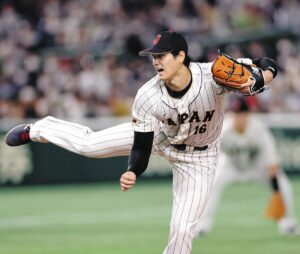
Shohei Otani’s training method
Shohei Otani undergoes thorough training in order to maintain his outstanding performance as a two-way pitcher and hitter.
His training method consists of three pillars: maintaining form, physical training, and mental training.
Below, we will explain each training method in detail.
Training to maintain form
Shohei Ohtani’s form maintenance training is important to maintain consistency in his pitching and batting form.
He meticulously checks his form during daily practice and makes minor adjustments as needed.
First, he uses video analysis to check his form.
Review footage of matches and practices to identify any fluctuations in form or areas for improvement.
This helps keep the form consistent.
In addition, by checking your form with a coach or trainer and receiving professional advice, you can maintain more accurate form.
Additionally, he performs specific drills to strengthen your form.
For example, for pitching, we do drills to smooth the movement of the shoulders and elbows, and for batting, we do drills to check the trajectory of the swing.
These drills are very effective in stabilizing his form.
Relationship between physical training and form
Physical training is directly linked to Shohei Ohtani’s ability to maintain his form and improve his performance.
His physical training is aimed at strengthening the muscles of the whole body in a well-balanced manner.
First, he focuses on core training.
Core strength plays an important role in both pitching and batting.
A strong core allows for smooth weight transfer and force transfer, increasing form stability.
He uses planks and medicine ball exercises to strengthen his core.
He also focuses on training his lower body.
The strength of the lower body is the source of power for pitching and batting, and a strong lower body supports stable form.
He improves his lower body strength through exercises such as squats and deadlifts.
Additionally, training your shoulders and arms is also important.
He focuses on training the muscles around his shoulders to keep them strong and flexible as a pitcher.
This reduces the strain on your shoulders and elbows, allowing you to maintain long-term performance.
Mental training and performance improvement
Mental training is also essential to Shohei Otani’s success.
By strengthening his mental health, he is able to remain calm even under pressure and perform at his best.
First, he incorporates relaxation techniques.
Learn how to relax before a game or after practice and refresh your mind and body.
By using breathing techniques and meditation, I keep my mind stable and improve my concentration.
Next, image training is also an important element.
He paints a successful image of himself before a match and creates a positive state of mind.
Imagery training is a powerful tool that allows you to visualize how you want to play and reflect that in reality.
Additionally, he practices positive thinking.
Even when faced with difficult situations or failures, always maintain a positive mindset and focus on the next play.
Positive thinking has greatly contributed to his improved performance.
In this way, Shohei Otani’s training method consists of three pillars: training to maintain form, the relationship between physical training and form, and mental training and performance improvement.
Through these training sessions, he continues to maintain his outstanding performance as both a pitcher and a hitter.

Form analysis and future prospects
Shohei Ohtani’s success relies heavily on his excellent form.
He is constantly analyzing and improving his form to continue evolving towards his future goals.
Below, we will explain in detail the enhancement of the form through data analysis, feedback to improve the form, and future goals and evolution of the form.
Enhance your forms with data analysis
Shohei Otani utilizes the latest data analysis technology to enhance forms.
In modern baseball, there are many tools available for detailed analysis of player movements and performance.
Otani actively incorporates these techniques and objectively evaluates his form.
As an example of data analysis, he analyzes the rotation speed, trajectory, and release point of the ball when pitching.
This allows us to find the optimal pitching mechanism and achieve effective pitching.
In particular, adjusting the consistency of his release point and the rotation rate of the ball are important factors in improving the sharpness of his pitching.
When it comes to batting, he uses data to analyze swing speed, batted ball angle, and force transmission at impact.
This allows me to see which parts of my swing can be improved and maintain efficient batting form.
Exercises based on data analysis are an essential means to take his performance to the next level.
Feedback for form improvement
In addition to data analysis, Shohei Ohtani also values feedback from coaches and trainers.
To improve his form, he takes advice from experts and incorporates it into his practice.
Feedback from the coach is essential to his technical development.
For example, when it comes to pitching form, we receive detailed guidance on things like shoulder and elbow movements, and the timing of weight shifts.
This improves your form consistency and efficiency, allowing you to pitch more effectively.
Also, feedback from the trainer plays an important role in his physical training.
We receive advice on how to maximize performance, including training content, intensity, and rest timing.
This helps prevent injuries and maintain stamina, achieving high performance over long periods of time.
Future goals and form evolution
Shohei Otani continues to evolve his form while always keeping an eye on his future goals.
His goals are to have more success in the major leagues and further improve his performance as a pitcher and hitter.
His future goals include winning a major league title and helping his team win a championship.
To achieve this, he constantly reviews and improves his form.
In addition to technological advances, we aim to continue to grow physically and mentally and maintain the best condition.
Ohtani also aims to be a role model for young players.
His success has been a great inspiration to many young athletes, and he continues to strive to live up to their expectations.
His training methods and form improvement process are valuable learning materials for other athletes.
In the future, we aim to improve performance in both pitching and hitting by incorporating even more advanced forms.
By actively incorporating new techniques and training methods and continuing to push his limits, his career will become even more brilliant.
In this way, Shohei Otani’s form analysis and future prospects consist of three elements: strengthening the form through data analysis, improving it using feedback, and evolving toward future goals.
By combining these factors, he is constantly improving his performance and continues to demonstrate his outstanding ability as a two-way pitcher and hitter.

Shohei Ohtani’s form as seen by fans
Shohei Ohtani’s pitching form and batting form are a big attraction for many fans.
His form is highly praised not only for its excellent technical performance, but also for its beauty and influence on young players.
Below, we will explain in detail the opinions and evaluations of fans, the beauty and charm of his form, and the influence and role model he has on young players.
Fan voices and ratings
Shohei Otani’s form has gained tremendous support from baseball fans around the world.
Fans have been praising his form a lot and are impressed with his technique and performance.
First, regarding his pitching form, fans have noted the consistency and speed of his release point.
His fastball hits over 100 mph and comes from a very consistent release point.
This speed and accuracy attract many fans, and watching him pitch is a joy.
He also has a great curveball, and watching him toy with batters is a must-see moment for fans.
Meanwhile, regarding his batting form, fans are impressed by the power and accuracy of his swings.
Ohtani’s swing is extremely fast, and the moment he makes impact with the ball elicits huge cheers from the crowd.
His home runs are especially impressive, and the way the ball flies deep into the stands is a great moment for fans.
Beauty and charm of form
Shohei Otani’s form is also highly praised for its beauty and charm.
His movements are very smooth, with a fluid sequence of movements.
This is a product of his training and skill, and provides a visual treat for fans watching.
The beauty of his pitching form lies in the harmony of his body movements. His movements are both powerful and graceful, as he uses his entire body to transmit power.
His pitching movements are even more beautiful when seen in slow motion.
Fans are mesmerized by the beauty of his form and watch every pitch without missing a beat.
The appeal of batting form is its dynamic nature.
Otani’s swing is extremely powerful, yet there are no unnecessary movements.
The sound of his bat hitting the ball and the way the ball flies captivates the entire stadium.
His form has become a role model for younger players and many fans strive to emulate his swing.
Influence and role model for young players
Shohei Ohtani’s form has become a role model for many young players.
His success and form has had a huge impact on the next generation of players.
By learning and adopting his form, many young players aim to improve their own technique.
Ohtani’s pitching form is especially helpful for young pitchers.
The consistency and strength of his form makes him an ideal model for young pitchers.
By learning his release point and how he uses his body, young pitchers can improve their own pitching techniques.
His mental strength is also a great source of encouragement for young players.
Regarding batting form, Otani’s swing has influenced many young players.
The mechanics of his swing, the way he grips the bat, and the way he shifts his weight are important factors for young players to improve their batting skills.
By following his form, young players can develop a more efficient and powerful swing.
As such, Shohei Ohtani’s form is a big draw for fans, and he also serves as an important role model for young players.
The beauty of his form and high level of technique continue to impress many people.
Shohei Otani’s presence occupies a very important position in the baseball world through his feedback and evaluations from fans, the beauty and charm of his form, and his influence and role model for young players.

